Are you a Quiet Speculation member?
If not, now is a perfect time to join up! Our powerful tools, breaking-news analysis, and exclusive Discord channel will make sure you stay up to date and ahead of the curve.
If you're like me, most of the excitement surrounding Standard revolves around which of its cards break into Modern. The worlds-apart nature of both formats guarantees that many Standard all-stars don't make it over this way, and some Standard duds boast impressive utility in Modern. Every so often, though, a card makes a big splash in both formats. Inspired by the Standard hype for Hostage Taker last weekend, I took it upon myself to see if I couldn't get the Pirate thieving in this format.
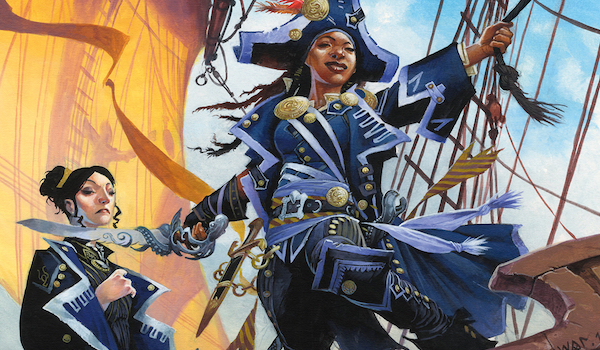
Today, we'll look at the findings from my week of testing Hostage Taker, and my own take on where she might belong.
Finding a Shell
This first step is the most obvious of the process, but also one of the more challenging: where can Hostage Taker shine? I knew I wanted to play her in an interactive deck featuring Fatal Push and targeted discard, and that I'm too restless a brewer not to splash a third color. To get started, I thought about what each one offered.
Core Components
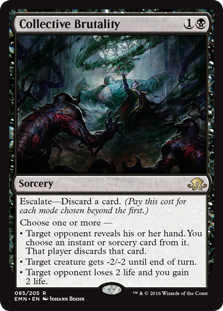 Targeted discard: Discard spells are uniquely terrifying in Modern, as no other form of proactive interaction can be used offensively and defensively with such grace; Collective Brutality is especially flexible. In our deck, they strip a removal spell to make way for Taker, or slow opponents down long enough for us to cast her.
Targeted discard: Discard spells are uniquely terrifying in Modern, as no other form of proactive interaction can be used offensively and defensively with such grace; Collective Brutality is especially flexible. In our deck, they strip a removal spell to make way for Taker, or slow opponents down long enough for us to cast her.
Permission: Unlike discard spells, counterspells are quite weak in this format. But we're already in blue, so they're at least worth a look for the sideboard.
Fatal Push: Handily gets us into the late-game Taker requires and beats up on most creature decks. The juiciest Taker targets are higher on the mana curve, leaving Push to clean up the rest.
Serum Visions: Nothing fancy here; just the bar for library manipulation in Modern.
Nameless Inversion + March of the Drowned: The Johnny in me messed around with this combo—usually alongside Thought Scour—a little too much for comfort before finally dumping it. The floor on March isn't so bad with Scours, though, since it can also return non-Pirate threats like Snapcaster Mage. If we get another Pirate on Hostage Taker's level in the next set, tribal-March might be worth revisiting.
Draws to Green
Mana dorks: Taker costs four mana, which is quite a bit in Modern—it doesn't make her uncastable, but it does limit the types of decks that can play her. Dorks mitigate this issue by accelerating into Taker a turn early, as well as helping cast the creature she exiles.
Tarmogoyf: Taker doesn't apply much pressure on its own, so some form of compact proaction is necessary to deal with big mana and linear combo strategies. Tarmogoyf ain't what it used to be, but man if it doesn't still apply a buttload of pressure and induce headaches for opponents without Fatal Push. Since we're already in dorks and discard with a green splash, Goyf is likelier to live past the villainous instant.
Build-around options: Traverse the Ulvenwald
Draws to Red

Damage-based sweepers: Red sweepers have been awesome in Modern for as long as I can remember, and that's still the case today. Pyroclasm remains my personal favorite, and it doesn't even knock out Taker.
Lightning Bolt: This blue-chip-staple cum utility-figurehead performs swimmingly in the aggro-control shells Hostage Taker demands.
Kolaghan's Command: With Taker in the picture, Command promises plenty of value in addition to its standard disruptive applications.
Blood Moon: There's nowhere to play it, but Blood Moon kicks butt right now. Eldrazi Tron, Valakut, and Grixis Shadow play a gross game of rock-paper-scissors atop the format, and Moon significantly disrupts all three. Removing Taker without fetches for revolt can also prove burdensome for opponents on black.
Build-around options: Rowdy Crew (with mana rocks and March)
Draws to White
Path to Exile: Best removal spell in the format. Given the options available to us today, and Taker's own coverage, Path is less a reason to go into white than an obvious include if we do.
Build-around options: Spell Queller, processor effects, Crib Swap (with March)
Early Testing Conclusions
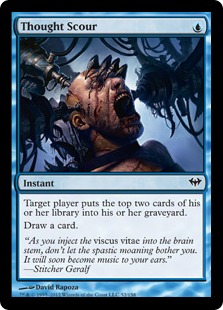 Messing around with Sultai decks taught me that running Taker alongside mana dorks was a winning combination. Taker dies to Bolt and to a revolted Push, and both spells are likely to gun down Noble Hierarch as soon as the Druid rears her head. Plus, dorks speed up Taker's deployment. The Sultai builds I liked best ran six Lilianas (4 Veil/2 Hope), Thought Scour, Snapcaster Mage, Goyf/Scooze, and delve threats alongside targeted discard and pushes. They ate up creature decks that didn't go insanely wide and couldn't for the life of them beat big mana.
Messing around with Sultai decks taught me that running Taker alongside mana dorks was a winning combination. Taker dies to Bolt and to a revolted Push, and both spells are likely to gun down Noble Hierarch as soon as the Druid rears her head. Plus, dorks speed up Taker's deployment. The Sultai builds I liked best ran six Lilianas (4 Veil/2 Hope), Thought Scour, Snapcaster Mage, Goyf/Scooze, and delve threats alongside targeted discard and pushes. They ate up creature decks that didn't go insanely wide and couldn't for the life of them beat big mana.
I also fiddled with some Grixis shells and found Blood Moon to work well with Hostage Taker. In terms of metagame coverage, it's nice that Moon plugs some holes in the Tron matchup. My problem with Grixis was that I lacked the utility of Sultai's cards—it had no Tarmogoyf to apply pressure with, Liliana, the Last Hope outperformed Kolaghan's Command, and incidental hosers like the walkers and Scavenging Ooze eluded the shard outside of Moon itself.
After a while, I remembered that I'd already built a deck running dorks, Moons, and off-color four-drops. Here's what grew out of that idle thought:
Turbogoyf '17 (1.0), by Jordan Boisvert
I'm certain this isn't the "optimal" shell for Hostage Taker, just as the default Bant Spirits isn't the optimal home for Spell Queller—the versatility of these creatures suggests they'll find homes across multiple archetypes, and the most successful host for either depends on how the metagame shapes up. That said, I figured it was as fine a place to start as any, so I stuck with Sultai Moon all week. Staying within a framework is crucial to my exploration process: I wanted to see what Hostage Taker could do in a deck finely tuned to both the metagame and my own preferences.
Breaking Down Sultai Moon
First of all, what is this mess of a deck? It's not all that foreign—for my first build, I just took the "Turbogoyf" Abzan Moon blueprint I introduced nearly two years ago (definitely follow that link if you don't remember) and made some key swaps:
-4 Siege Rhino
-4 Abrupt Decay
-4 Lightning Bolt
-2 lands
+4 Hostage Taker
+4 Fatal Push
+4 Collective Brutality
+2 Tasigur, the Golden Fang
The shell of course evolved from there, as evidenced by the above decklist.
What's New
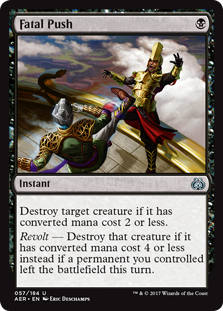 Brutality replaced Bolt as reach/toughness-based removal, and man is it great in this deck. We've always wanted more discard outlets than just Faithless Looting; since we stop making land drops at four mana, those Lootings were in high demand for Abzan Moon, and frequently just better Harmonizes with a Moon on board. Targeted discard helps Goyf survive in Fatal Push Modern and otherwise clears the path for our haymakers to resolve and wreak havoc. It also gives us a source of lifegain now that Rhino's leaving.
Brutality replaced Bolt as reach/toughness-based removal, and man is it great in this deck. We've always wanted more discard outlets than just Faithless Looting; since we stop making land drops at four mana, those Lootings were in high demand for Abzan Moon, and frequently just better Harmonizes with a Moon on board. Targeted discard helps Goyf survive in Fatal Push Modern and otherwise clears the path for our haymakers to resolve and wreak havoc. It also gives us a source of lifegain now that Rhino's leaving.
Fatal Push is a more obvious upgrade to Abrupt Decay, which I started running in my Turbogoyf decks with the primary function of executing my opponent's Tarmogoyfs. Against any deck with cheap creatures, Push is the best card in Modern when it comes to surviving into big-play territory, and a blessing for this archetype.
I also found there to be too many lands and shaved a pair for 2 Tasigur, the Golden Fang. I've discussed the banana man in this deck before, but negatively; he's much better in this build. Brutality helps power him out early while making use of the crappy cards we net off his ability, and Tasigur conveniently walls Thought-Knot Seer. Critically, six-drops are very annoying to kill in Modern right now.
Later Adjustments
I somehow still felt too mana-heavy in testing, and cut a couple lands for Dimir Signet. Having Signet in the deck lets us rush out turn-two Moons without any of our secondary colors and reliably Loot into them, which let me cut the couple blue fetches and the basic Island I ported over from Abzan Moon. Signet also provides a new card type for Tarmogoyf, and we've got plenty of ways to discard it. Lastly, Signet gives us another strong two-mana play should our dork die or we lead with a removal spell, as it immediately ramps us into a four-drop. Shaving lands for Signets meant going up in number of mulligans, but I watched for this drawback closely and wasn't bothered by it. The hands we end up keeping are just stronger now, and we flood less; our good hands beat opponents even if we're way down on cards, since Moon can end games on its own.
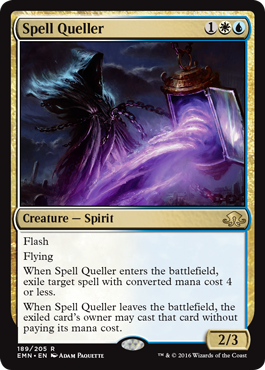 After getting bodied by Spell Queller at a locals, the other change I made was to re-adopt Lightning Bolt. I found room by trimming a Brutality and a Push, since Bolt covers similar ground. Its utility really is unparalleled and I'm happy to have it back.
After getting bodied by Spell Queller at a locals, the other change I made was to re-adopt Lightning Bolt. I found room by trimming a Brutality and a Push, since Bolt covers similar ground. Its utility really is unparalleled and I'm happy to have it back.
I started with Negate in the sideboard and then went over to Thoughtseize, a more reliable piece of disruption here with more synergy with our gameplan. The Rabblemasters there come in for Taker or dead interaction against linear decks, where they join Goyf in applying lots of pressure very quickly. Kolaghan's Command gives us a grind plan for slug-fests.
Assessing the Taker
One problem I've encountered with Moon decks is the tempo loss incurred by spending three mana on an enchantment; if opponents already have creatures in play, they can sometimes make short work of us before we can recover. That's why Tarmogoyf pairs so well with Moon: it comes down first, offsetting our do-nothing next turn.
Another important role to fill in Moon decks is what comes down after. Huntmaster of the Fells is fine on the back foot so long as we have a turn or two to flip him; Siege Rhino addresses only specific kinds of game states, doing nothing against wider boards or ones populated by fliers. Similarly, no four-mana planeswalker ever gave me the coverage I desired in such situations. When we're under pressure, though, Hostage Taker is a fine follow-up to Blood Moon, and one that combines especially well with our other cards—casting a spell with Taker helps transform Ravager of the Fells, lets us stockpile cards in hand for big Looting turns without leaving our mana unspent, and mitigates flooding by giving us something to do with the extra mana (resolve Taker, immediately cast its hostage).
Taker's Downfall
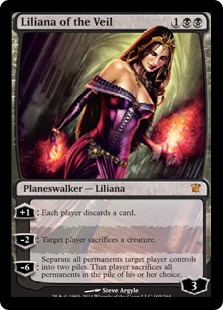 While I did commandeer a Wurmcoil Engine and an Oblivion Ring in testing, Taker's best matchups are obviously not the linear ones. Against decks without creatures, we just want to back our Moons up with a lot of pressure, essentially rendering Taker dead in hand.
While I did commandeer a Wurmcoil Engine and an Oblivion Ring in testing, Taker's best matchups are obviously not the linear ones. Against decks without creatures, we just want to back our Moons up with a lot of pressure, essentially rendering Taker dead in hand.
Additionally, my testing with the Sultai deck revealed to me that Taker's role in creature mirrors was vastly similar to Liliana of the Veil's: to create a big tempo swing and force opponents to expend more resources answering this one card. The dream scenario of Taker resolving and stealing a Goyf we can then cast indeed turns the tide in those matchups. But often, so does just slamming a Liliana, and while Lili doesn't put us as far ahead as Taker can in certain situations, or address stuff like Cranial Plating, she has far wider applications. Taker is quite weak against decks like Valakut or Ad Nauseam, for example, whereas an early Lili puts away games in those matchups.
For Sultai Moon at least, I found the correct step forward was to abandon blue entirely and just run Liliana. I don't think such a direction was ideal two years ago, when we desperately wanted more powerful threats in that slot; with Brutality and Push in Modern, though, I think Turbogoyf gains enough tools to function without a fourth color splash.
Here's the updated deck:
Turbogoyf '17 (2.0), by Jordan Boisvert
Taker's Future
This analysis revealed Taker to be a narrower, weaker Liliana of the Veil. But that doesn't mean it's doomed not to see Modern play. Taker still has some unique applications, like removing artifacts pre-board (Grixis has Kolaghan's Command, but Esper and Sultai don't) and exiling any creature (something straight UB, without Terminate or Path to Exile, lacks). As such, I expect it to become a consideration for BGx Rock decks looking to splash a third color.
These kinds of decks might actually benefit to some degree from running more than four Liliana of the Veil-style effects, and Taker definitely gives an edge in the midrange mirror. The Pirate's applications with Chord of Calling, Traverse the Ulvenwald, and other creatures-matter cards also give me hope it will be picked up as a bullet in other strategies.
 Lastly, I think Taker may have something to offer the creature-heavy white decks we've seen around Modern. While Death & Taxes represents the shell's most simple incarnation, many versions splash black for Wasteland Strangler or blue for Spell Queller. If these decks can run Eldrazi Temple, there's got to be a way to make an Esper build work. Tidehollow Sculler, Thalia, Guardian of Thraben, Eldrazi Displacer, Spell Queller, and Hostage Taker all compliment each other quite well in terms of effects, and Taker handily replaces Thought-Knot Seer on the curve. Just imagine flashing her in with Aether Vial—shiver me timbers!
Lastly, I think Taker may have something to offer the creature-heavy white decks we've seen around Modern. While Death & Taxes represents the shell's most simple incarnation, many versions splash black for Wasteland Strangler or blue for Spell Queller. If these decks can run Eldrazi Temple, there's got to be a way to make an Esper build work. Tidehollow Sculler, Thalia, Guardian of Thraben, Eldrazi Displacer, Spell Queller, and Hostage Taker all compliment each other quite well in terms of effects, and Taker handily replaces Thought-Knot Seer on the curve. Just imagine flashing her in with Aether Vial—shiver me timbers!
Knave-r Give Up
It's always been fun for me to try out Standard powerhouses in Modern—among the most recent, Heart of Kiran, Smuggler's Copter, and Emrakul, the Promised End. Sometimes, as with Spell Queller and Reflector Mage, Standard hits become Modern hits; others, as with Aetherworks Marvel, they fall flat. I expect Hostage Taker to mostly do the latter, although I'd be surprised if she didn't find a niche somewhere. But believe you me, matey: a niche.





Wouldn’t Sower of Temptation or Threads of Disloyalty be better analogues? Hostage Taker is a cool card, but doesn’t seem too appealing. Tapping out on the fourth turn to o-ring a creature or artifact that I can hopefully steal on the next turn is pretty ho-hum. In most cases, I’d rather play Sower…*if* I was in the market for 4cc semi-permanent removal.
Taker is a lot more flexible since it hits artifacts, and 3 is a much larger number than 2 in Modern these days. Kolaghan’s Command, Collective Brutality, Pyroclasm, Kozilek’s Return, Tarfire… none of that stuff kills a Taker. Taker also gives opponents a one-turn window to interact with it, since we can untap and cast their permanent. It’s not like they have a bunch of turns to draw an out and get their guy back because they’re only getting hit for 2 in the air every turn. I think it’s a huge improvement over Sower, at least in terms of text (color cost and typing are more debatable).
Threads is pretty much useless now that Push is around IMO. One of the main benefits of Taker is that it hits something like Wurmcoil Engine, that, say, BGx decks have a terrible time answering otherwise.
Not terribly surprising. But really if I was going to plug this in a deck it would probably be one of those sultai chord of calling decks that would run like gonti lord of luxury. Chord likes having a fiend hunter and sultai cant actually use hunter itself anyways – so in addition to being a better version of fiend hunter (mostly) you also take advantage of the colour shift.
Also makes it a one-of but gives you five virtual copies so reduces drawing it when it sucks while letting you access it when its good.
Oh and lets you eot chord for hostage taker untap cast their card.
Same sort of deal with Vial—flash it in EOT, cast the creature! Didn’t know there were BUG Chord builds running around, but Taker is an easy upgrade to Gonti for sure.
They arent very good I dont think but they exist – think there was a deck tech for it on mtggoldfish a while back. They may have been running eldritch evolution too which isnt too bad if youve already cast the taken card and upgrade your hostage taker into a grave titan or whatever.
But chording eot for a hostage taker sounds a lot more like a good modern play than tapping out for one on turn 3 or 4, and a lot more realistic than some ubx vial deck that ticks a vial up to four (mostly bc you still need multiple copies for that to work and the card sometimes just flat out sucks so you dont want 4 of them – let alone forcing a vial up to enable it).